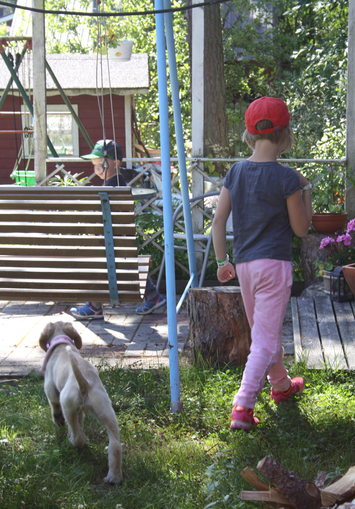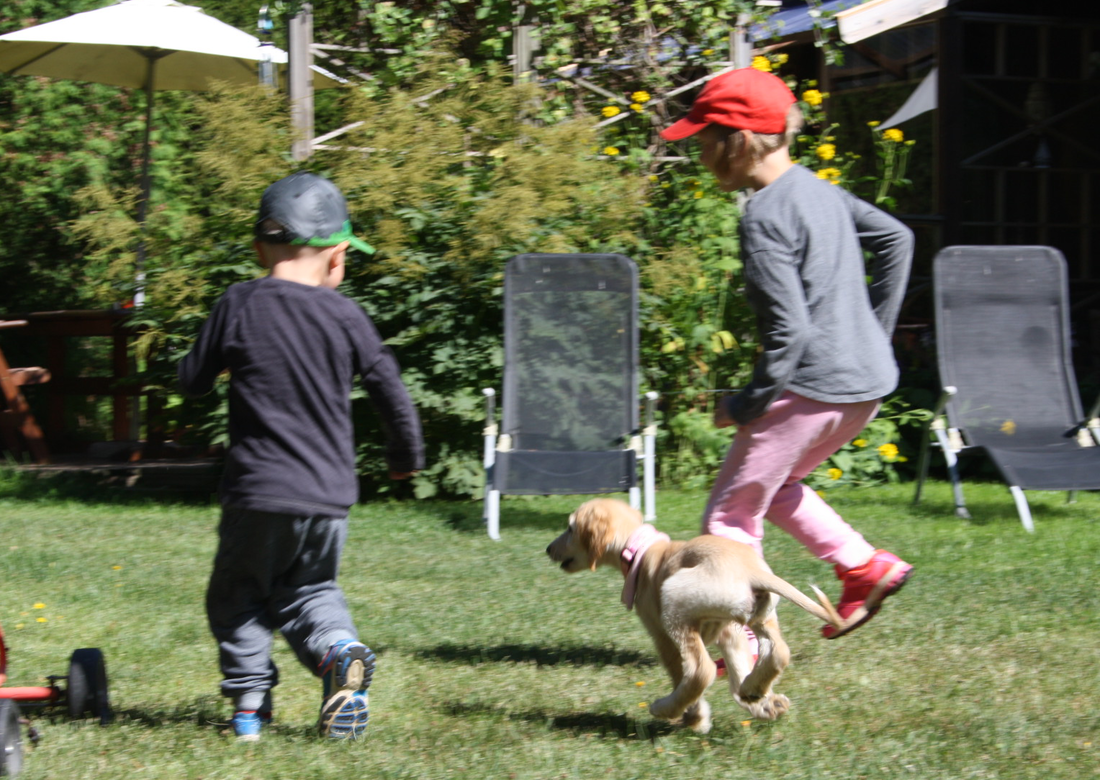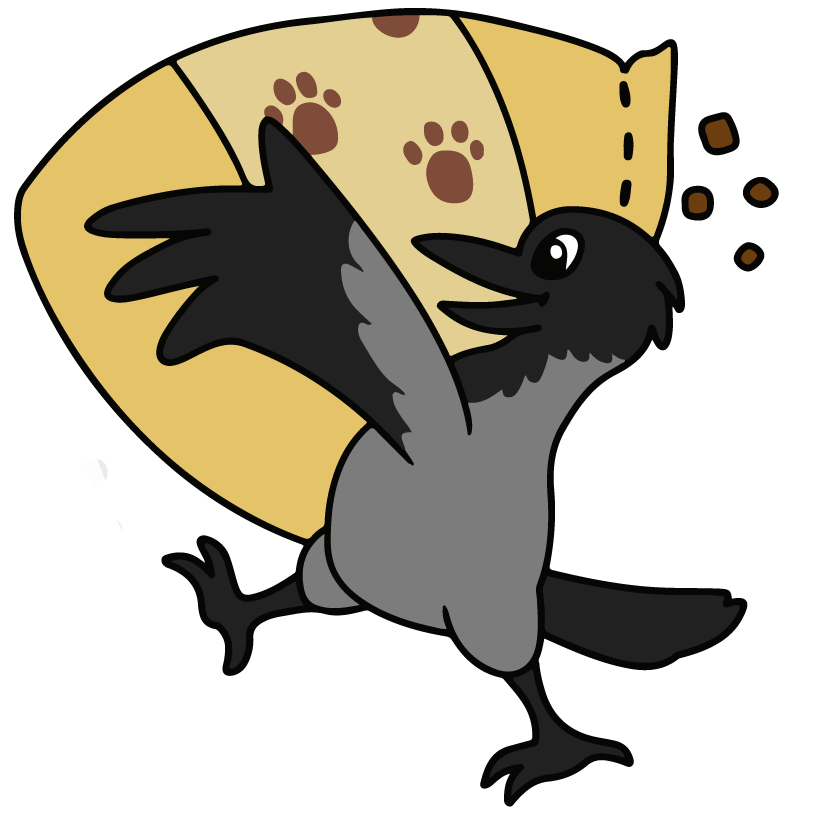Socializing your puppy is probably the most important thing you can do. Many of new puppy owners will focus on simple tricks such as sit, stay, down when they get their puppy, and it is very true that it's easy to train a small puppy. The most important thing to focus in, however, is making the dog familiar with this surrounding world we live in and all the weird stuff it is supposed to tolerate without stress when it gets younger.Breeders should do the basic sozialicing before the pups even leafe their mother's side. Getting the pups outside to smell fresh air (if the weather and temperature allows it) and getting them used to different surfaces is very important when raising a litter of pups. Meeting people before moving to one's own family is also important. If the family has other, vaccinated, familiar dogs living in the house, meeting and playing with them is also very beneficial to the pup. The thing to remember by the new owner is that no matter how much the breeder does work with the pups, the main work is left to the new home. The timing is also crucial, since from 3 weeks old to 12 weeks old is the phase the pup is most open to new things. It is called the socialization stage, and meeting as many people as possible and going to as many safe places as possible is the most effective at this stage. After this the pup will become a little less open to new things and warming up slows down. It may also start to have surrealistic fears, which is perfectly normal but may make meeting new people and getting accustomed to new places less effective and more stressful. The fear stage will pass eventually, but if one skips the early socialization and waits until the fear stage is over one misses the most sensitive weeks of learning in the beginning. That may have later negative effects on how the dog sees the world. How to develop social skills of your puppyPups don't get their perfect vaccinations until 12 weeks or after. This means the pup is not welcome to most dog happenings and you should also be wary with meeting strange dogs in general. However, meeting familiar, friendly dogs you know are vaccinated and taken care of is not only possible but also adviced. This way the pup learns how to behave with other dogs. It has learned basics of this in a litter box with it's mother and siblings and possible other dogs of the breeder's family, but developing these skills with new safe friends is always beneficial. Be sure that the dogs the pup meets are friendly. The time of getting to tolerate unfriendly dogs is not at this point. The pup needs to meet balanced dogs, so they can show balanced way of behaving. Meeting new people is crucial too. Some breeds are more aloof than others, some pups are friendly from the start. Mixing shyness with aloofness is very common. A shy dog shows excessive amount of calming signals and stress when it meets new people. Aloof pup just simply ignores the new people or monitors them from afar at first. Wary dogs don't want to come near new persons in the beginning and may show signs of, well, being wary when they approach them, but this passes eventually as the pup learns these people are of no threat. No matter there is a clear difference between being aloof and wary and being shy and having bad nerves, it is a fact that wary, aloof breeds are more prone to become nervous, shy and unsocial if they lack sozialication. This is why one needs to put some extra work in sozialication if one takes in some of these breeds or dogs. Taking the pup to experience different types of surfaces or at least making sure it gets to know them at home will pay back later when the pup needs to walk calmly in concrete, grass, steel, asfalt, stone, sand. One can also train the pups ability to ignore moving surfaces by building small unstable platforms that are safe for the pup to investigate. Some pups go on these platforms themselves, some might need encouraging, but a small pup is easy to train if it's nerves are good. If they are not, it takes more time and effort to train the dog and one needs to be careful not to pressure the pup too much. This can also happen with strong, brave pups, but they can take more than their nervous counterparts. The last thing to think is if there is a mall or some sort of a market place filled with people you can take your pup to. Make sure you have good leash and harness/collar, and make sure not to leave your pup too alone. Don't protect it too much, either. Carrying it around in your lap the whole time doesn't really teach it to face this environment by itself. Getting to see these loud, crowded places is essential for example hobby, working and show dogs who are supposed to be able to relax in these environments when they are older. It is beneficial for the others, too. Tolerating varietyDogs are slaves of the routine, and if adult certain color people of certain sex are the most they meet, they can act stressed and wary, even scared among other kinds of people. Dogs don't understand our social norms and what is considered polite and what is not. They will bark at disabled people, people that talk differently, people that are of different color they are used to, kids, elders, if they are not taken to meet them and be properly socialized. One common mistake to do when raising a pup is bad socialization. Many people don't understand just how much it may take to make your dog experience new places and people and other dogs without fear and stress. This doesn't mean going to the market once or playing with neighbor's kids. This means meeting as many different people in as many different places as one just possibly can without putting too much stress on the puppy. After all, we live in a very odd world in the eyes of the dog. Many of the things we expect from our dogs is against their nature, and therefore we must train and help them to understand what we expect of them.
Also remember that tolerating is not the same thing as liking. Your dog doesn't need to like kids any more than you do, but neither of you can go snapping at kids just because they are kids. You can teach your dog to take space and go away when it is bored and tired of children, and as an owner you must then make sure the children, in return, let your dog be alone.
Mr. Hyperactivity and Ms. Dominance love children and they are very eager to play with them, poke them, sniff them and lick them. Mrs. Aloofness could care less, Mr. Arthritis doesn't really prefer kids either. Both of the latter know how to take their own space when they get tired. Mr. Arthritis may sometimes forget that, since his is a nervous, stressed character, and in that case I as his owner have to tell him to leave, go somewhere to lay and calm down. Stress is a poor excuse that he would go around snapping at children. That is not to be tolerated and I need to make sure he is of no threat. In return, if you are a parent, teach your children to leave strange dogs alone and respect dog's own space. The most unnatural situation for dogs and kids alike is when the dog is tied for example in front of a shop, it is alone, and unfamiliar kids go to pet it. In this situation the dog, even the one that knows how to give space, doesn't have any means to escape. Things can escalate, and therefore teach your children to stay away from strange dogs and always ask permission to near them. Also don't tie your dogs in front of shops alone.
0 Comments
Leave a Reply. |
Mistä on kyse?Koko elämänsä koiria harrastaneen raakaruokintafriikin ajatuksia, pohdintoja ja elämää koiralauman kanssa. Seuraa meitä
Päivitämme säännöllisen epäsäännöllisesti myös Facebookiin.
Historia
June 2022
Kategoriat
All
|




